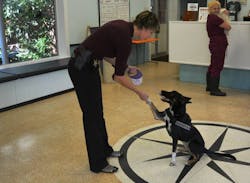Can a canine help find digital evidence?
For those who work with public safety canines, the long and furry road to professionalism is a labor of love. The dog is usually entrusted to one handler for the rest of its career. The two eat, sleep and work together. These specialty pups have always held their own in police work and continue to surprise us with what they are capable of.
We know that a dog’s sense of smell is potent and precise. Once trained on a substance or material it will hunt down that scent until it alerts on the child/fugitive/bag of drugs. The same sense of smell can even detect carcinoma in patients long before an MRI corroborates. This ability is far more powerful than anything else we as humans could accomplish or devise, which is why animals continue to play a leading role in investigations.
It just so happens that these days, a significant number of investigations are morphing from the physical to the digital. But dogs have ability here, too. When electronic components containing incriminating materials are hidden away, investigators are turning yet again to their tried-and-true employed “noses.” This is what happened in the arrest of former Subway spokesman Jared Fogel. Fogel was sentenced to more than 15 years in prison for receiving child pornography (mostly videos) and having sex with minors. In the course of the investigation a black Labrador named Bear played a key role in the arrest. The two-year-old rescue was one of a handful of dogs in the country trained to sniff out electronic data devices. He was able to ferret out the smoking gun—or in this case—the plastic thumb drive, so Fogel could be charged for his offenses.
How do they do it?
We’ve heard of canines who go to work in a corrections setting to detect cell phones. The idea here, when it comes to finding contraband materials on electronic devices, is very similar. Like Bear, Winnie, another Labrador retriever (this time with the Massachusetts State Police) is also one of few dogs across the county certified in this task. The two-year-old pup is trained by her handler Trooper Christopher MacDonald to locate cellphones, DVDs, USB drives and SD cards. She does it by detecting certain chemical compounds specific to parts used in the manufacture of the devices. When child pornographers and like fugitives who deal in digital try to conceal the evidence of their crimes with these items, Winnie will ferret them out.
“Dogs can do everything from detect carcinoma to finding narcotics and explosives,” says President of the American Police Canine Association (APCA) Michael Johnson. “This area (detecting electronics) is new to our association. I think it’s going to be a great field.”
At this time only a few agencies across the county even train their dogs to smell components of electronic media. As for those agencies who do, they are typically approached by a task force asking for assistance in a specialized cause. That’s what happened recently in Bradenton, Florida. The local child services group Crimes Against Children approached the police department following the Jared Fogle case and basically asked, “Can we do this here?”
Meet Gia
Dennis “Richie” Cunningham of the Manatee County Sheriff’s Office in Bradenton was intrigued. He had spent the better part of the last 18 years researching canine behavior as it relates to their natural instinct and works to develop the bond between handler and dog. He says, “A dog will do what the handler wants out of respect for the handler.” Cunningham’s own dog, ____ was killed ……….
Manatee County Sheriff’s Office currently has nine dual purpose dogs, two single-purpose narcotics dogs and a ballistics firearms dogs, and so they’ve added one more to the mix: a dog that specializes in electronics.
“I have spent a good deal of my personal time and money traveling to learn from those that are held in high regard in the fields of canine instincts and behavior. I have also studied a good deal of empirically supported research on canine behavior. I used all of what I have learned, along with my law enforcement canine experience, to develop the training program we use [here],” says Cunningham. He works closely with canine trainer Deputy Tom Franklin to ensure the highest quality training for both the handler and canine. They typically acquire untrained canines at a young age, generally around 15-17 months old. Gia, the newest patrol canine, was about eight months old when she was rescued from a local shelter. “Gia is younger than we usually start with, but she was worth the risk,” he says.
Cunningham says the young age of the canine allows for a stronger bond to be developed and allows the canine to naturally develop their social standing in the pair. “The young canine develops their instinctual role in the pack (handler and canine) as the beta to the handler. Mature canines that are paired with handlers will require more physical correction to put them in their place, as they have developed their instinctual behaviors by way of dealers and/or sporting dog programs (e.g., KNPV and Schutzhund). We spend extra time on the initial bonding stage to make the training phase less stressful for the canine.
Today 16-month-old Gia has already performed a handful of search warrants. Cunningham took training up a notch when he passed out sanitized thumb drives to people around the unit to hide at their homes so Gia could find them. “The state attorney hid a thumb drive …. in his wall and sure enough Gia found it,” he says.
What’s more important—breed or bond?
Like Cunningham, Johnson agrees success is all about repetition and conditioning. He says trainers typically need to present an odor at least 40 times before a dog really grasps it. He anticipates dogs will continue to play a bigger role in child pornography and human trafficking cases. Investigators will still need search warrants to find items like hard SD cards and USBs… but the dogs might find where they are hidden away—and much quicker!
So are some types of breeds better than others at specialized sniffing? For instance, cadaver dogs are typically German Shepherds and pit bulls. And although you’ll often find Labs in the spotlight, some sheriff’s offices might recruit a mixed breed. Todd Jordan, the Labrador Bear’s “dog whisperer” in the Jared Fogel case, candidly told NBC, “Labs are the best on this, they’ll do anything to please their owner. “But that could have just been a case of personal bias.
APCA’s Johnson points out that most times “law enforcement doesn’t get tied into breeds.” Public safety dogs are bred for performance, not looks. And a good relationship with the handler is imperative.
“Just about anything you want to find, a dog has that capability. It’s all about the bond,” Cunningham agrees. “I had Detective Zimmerman (Gia’s handler) and Gia spend several weeks bonding prior to the start of her odor work. Gia was finding thumb drives before she was a year old. Though we still use many traditional reward methods, she seems to be more concerned with the excitement Detective Zimmermann gets when she alerts on a hide.
“I have found that a strong bond established at the start will shift the canine to an ‘I want to work for my partner,’ from an ‘I have to work for my partner’ mentality. I have observed the need for physical corrections to be reduced by 75 percent or more. Our canines are very effective at odor and patrol work, and are happier in the process.”
[conclusion]
Are you ready for a sniff-off?
The APCA Sniff-Off began in 2004. Law enforcement agencies across the country bring their four-legged partners to participate in different scenarios and each team is evaluated on a points system. For examples, dogs must find drugs alongside a vehicle or inside a building. At the end, three teams are awarded plaques.
“It’s all in fun and it keeps teams motivated,” says APCA President Michael Johnson. “Some of these teams train for weeks and weeks beforehand. It shows trainers what their weaknesses are, and what to work on.”
One bad habit that’s easy to slip into is conditioning. Teams have the tendency to train at the same place, and some of it’s due to a lack of options. “If you keep going to the same location it programs the dog to perform like a robot in that location. You always have to challenge them,” he says.
Next year’s Sniff-Off will be March 4 in Indiana (www.theapca.com).

Sara Scullin
Sara Scullin was the Editor of Law Enforcement Technology magazine, a monthly business-to-business publication that covers technology trends and best practices for public safety managers. LET is part of SouthComm Law Enforcement Media, which also publishes Law Enforcement Product News and Officer.com. Sara had covered the law enforcement industry since March 2008.



